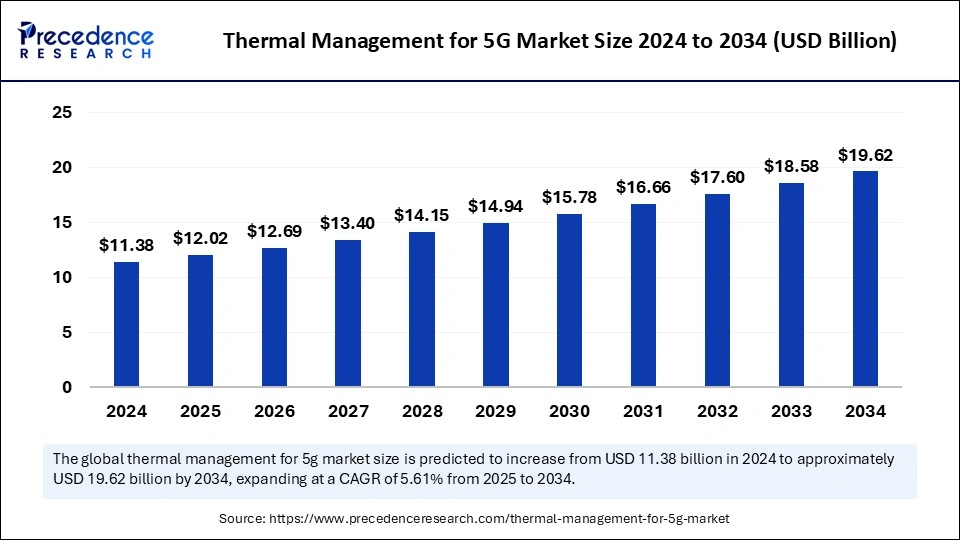Thermal management for 5G market to expand at a 5.61% CAGR, increasing from USD 11.38 billion in 2024 to approximately USD 19.62 billion by 2034 globally.

Thermal Management for 5G Market Key Takeaways
-
In 2024, Asia Pacific held the largest share of the 5G thermal management market.
-
North America is projected to grow significantly during the forecast period.
Thermal Management for 5G Market Overview
The thermal management for 5G market is experiencing significant growth due to the increasing adoption of 5G technology worldwide. The deployment of 5G networks requires high-performance equipment capable of handling large data loads, resulting in increased heat generation. As 5G networks operate at higher frequencies and utilize massive multiple-input and multiple-output (MIMO) systems, managing heat dissipation becomes a critical challenge. Effective thermal management solutions, including advanced cooling technologies and materials, are essential to maintain optimal performance, reliability, and longevity of 5G infrastructure components such as base stations, data centers, and mobile devices.
The demand for efficient thermal management systems has surged as telecom operators and equipment manufacturers aim to minimize downtime, enhance energy efficiency, and prevent overheating issues. Various innovative solutions such as heat sinks, liquid cooling systems, phase change materials, and thermal interface materials (TIMs) are being integrated into 5G devices to address the thermal challenges effectively.
Market Drivers
-
Increased Power Density in 5G Infrastructure: 5G technology involves higher power densities due to the use of small cells, MIMO antennas, and edge computing, leading to a rise in heat generation. Advanced thermal management systems are required to dissipate this heat efficiently, ensuring optimal device performance.
-
Growing Deployment of 5G Base Stations: The widespread installation of 5G base stations across urban and suburban areas has driven the need for effective cooling solutions. These base stations operate continuously, requiring efficient thermal management to prevent performance degradation and equipment failure.
-
Expansion of Data Centers: The surge in data traffic generated by 5G networks has resulted in the expansion of data centers, which demand sophisticated cooling solutions. Thermal management technologies play a critical role in maintaining optimal temperatures in data center equipment, ensuring reliable operations.
-
Rising Demand for Compact and High-Performance Devices: The proliferation of 5G-enabled smartphones, IoT devices, and other connected technologies has increased the need for compact, high-performance devices with effective thermal management solutions to prevent overheating and prolong lifespan.
-
Advancements in Thermal Interface Materials (TIMs): Innovations in thermal interface materials have improved heat dissipation in 5G devices. Enhanced TIMs ensure efficient heat transfer between electronic components and heat sinks, reducing thermal resistance.
Market Opportunities
-
Development of Liquid Cooling Systems: Liquid cooling systems offer superior heat dissipation compared to traditional air cooling systems. The growing adoption of liquid cooling solutions in 5G infrastructure presents a lucrative opportunity for thermal management system providers.
-
Integration of AI and IoT in Thermal Management: The use of artificial intelligence (AI) and the Internet of Things (IoT) in thermal management can optimize cooling performance by enabling real-time monitoring and predictive maintenance. These technologies can reduce operational costs and enhance system efficiency.
-
Expansion of Edge Computing Applications: The proliferation of edge computing applications in 5G networks necessitates effective thermal management solutions for edge devices and micro data centers. This trend creates growth opportunities for advanced cooling technologies.
-
Emergence of Advanced Phase Change Materials (PCMs): The integration of phase change materials in thermal management systems offers a promising opportunity by improving heat absorption and dissipation, ensuring consistent thermal performance in 5G equipment.
Market Challenges
-
High Initial Investment Costs: The implementation of advanced thermal management systems involves substantial initial costs, which can be a barrier for small and medium-sized enterprises (SMEs) seeking to adopt 5G technology.
-
Complexity in Thermal Design: Designing efficient thermal management systems for 5G infrastructure is complex due to the high density and power requirements of 5G equipment. Overcoming these design challenges requires specialized expertise.
-
Energy Efficiency Concerns: The increasing power consumption of 5G networks places a burden on energy resources. Thermal management systems must balance heat dissipation with energy efficiency to ensure sustainable operations.
-
Limited Standardization: The lack of standardized thermal management protocols for 5G infrastructure poses challenges in ensuring consistent performance across different devices and network environments.
Regional Insights
-
Europe: Europe is witnessing rapid growth in the thermal management for 5G market, driven by the extensive deployment of 5G infrastructure in major countries such as Germany, France, and the UK. Strong government initiatives to promote 5G adoption further boost the demand for efficient thermal management solutions.
-
North America: The North American market is experiencing steady growth due to the early adoption of 5G technology and the presence of leading telecom operators investing in advanced cooling solutions. The region’s robust data center industry also contributes to the demand for thermal management systems.
-
Asia-Pacific: Asia-Pacific is emerging as a dominant market, driven by the rapid rollout of 5G networks in China, Japan, and South Korea. The high concentration of electronics manufacturers in the region supports the growth of the thermal management market.
-
Middle East and Africa: The Middle East and Africa region is gradually adopting 5G technology, with increasing investments in telecom infrastructure creating opportunities for thermal management solution providers.
Recent News
-
February 2025: A leading telecom equipment manufacturer announced the launch of a new liquid cooling system designed specifically for 5G base stations, enhancing heat dissipation efficiency and reducing power consumption.
-
January 2025: A prominent European data center operator collaborated with a thermal management technology provider to implement AI-driven cooling systems, improving energy efficiency and optimizing 5G network performance.
Thermal Management for 5G Market Companies
- H.B. Fuller
- Dow
- Solvay
- Bergquist
- 3M
- Rogers
- Laird
- TDK
- Henkel
Ready for more? Dive into the full experience on our website!